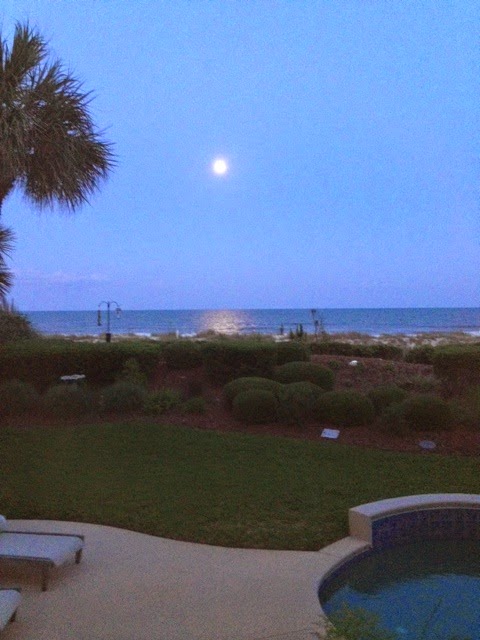First of all it is not actually a waterway in the way that you may be thinking. The ICW is really a series of connected river, creeks, bays, sounds, and sometimes man-made canals through which a course can be plotted that allows a boat to stay in protected waters as opposed to the open sea.
Protected is a relative term. If it is very windy the Atlantic or the Gulf of Mexico will have the highest wind speeds (because there is no land mass to stop or slow the winds), and thus the waves will be higher. Also at a coastline the waves pile up and so the water is rough. Thus most boaters, at least those in our size and type of boat prefer to remain in the ICW.
This is where the relativity comes into play. Generally the man-made cuts and the smaller rivers remain calm in all but the strongest storms, and if the forecast is that stormy we stay in port. In the bays and sounds however it can get rough. In fact the worst whooping we ever got was on smallish (as opposed to a large Bay) Choctawhatchee Bay along the Florida Gulf coast near Destin. Bays and Sounds are larger and wider bodies of water that are generally open to the sea on at least one end. Thus a strong wind, coupled with their often shallow depth will kick up some fairly tall waves rather quickly. This is especially true if the wind is blowing opposite of the way the tide is flowing.
But I digress - back to the ICW. The various rivers, creeks, man-made cuts, and bays/sounds connect to each other and together, as a composite, they are called the Intercoastal Waterway. For example when we left Washington, NC we followed the ICW to Elizabeth City, NC. In order to do this we traveled down the Pamlico River to the Pungo River; then through the man-made Pungo-Alligator Canal to the Alligator River. The Alligator River empties into Albermarle Sound which we traveled across in order to reach the Pasquotank River leading to Elizabeth City and the Dismal Swamp Canal. From Elizabeth City we will travel the Pasquotank R. to the Dismal Swamp Canal to the Elizabeth River into Portsmouth/Norfolk where the Atlantic Intercoastal Waterway terminates and boats enter Chesapeake Bay. I hope this wordy epistle clarifies, somewhat, exactly what I mean when I mention the ICW. Then again it could be just too much information.
Albermarle Sound is know as a generally snotty body of water and most boaters give it a lot of respect. In other words if it is windy stay off of Albermarle. Fortunately we have always chosen well and have not had a really bad ride across - but it is generally either a rolly or a choppy ride. In four trips across I have never seen it calm, this trip it was rolly. It is about 20 miles from the protection afforded by the Alligator, until we are far enough up the Pasquotank to be protected from the west or southwest. While it isn't far it takes up about two and a half hours to travel this distance.
Before we cross Albermarle we generally stop for the night in the Alligator River Marina run by Miss Wanda. This conveniently located marina, right at the mouth of the Alligator River, is in the middle of nowhere. It is a combination marina/gas station where people can fuel as they travel to the Outer Banks by car. Stopping in this location allows us to get an early start across the sound the next day before the wind builds. It also gives us a chance for a mighty fine fried chicken dinner. Miss Wanda, who also doubles as the waitress, is quick to tell you when you check in that they "close at eight, so if you want to eat be here no later than 7:00". We were there at 6:30 (just in case) and the chicken did not disappoint!
Elizabeth City is one of our favorite stops. They are known among cruisers as "The Harbor of Hospitality". In 1983 the city built Mariner's Wharf along their waterfront. This complimentary dockage for traveling boaters was funded with contributions from businesses and individuals interested in reviving the downtown area by drawing visiting boaters to stop there. In the fall of that year two retired gentlemen, Fred Fearing and Joe Kramer, were hanging out on the docks to welcome the visiting mariners and Fred decided to clip some roses from his wife's garden and give to ladies on the boats. The concept took off and "The Rose Buddies" were born. For many years Fred & Joe greeted boats and helped them tie off. When Joe passed on his rose bushes were transplanted to the wharf and Fred still greeted boaters every afternoon with a rose for the Admirals.. We were lucky enough to meet Fred Fearing on our first trip through the area in the spring of 2007 and were treated to one of his legendary wine & cheese parties. Unfortunately Fred passed on in the fall of that year. Today Gus has replaced Fred and he continues the tradition of helping boaters get settled and tells them about his community - but you have to cut your own rose. Over the years Elizabeth City has added restroom and shower facilities, and if you know where to look (or if you ask Gus), there is even a source for water for filling your tank.
 |
| The rose bushes are just beyond the foreground of this photo |
 |
| We were docked right where this blue boat is. Step off the stern and smell the roses! |


















